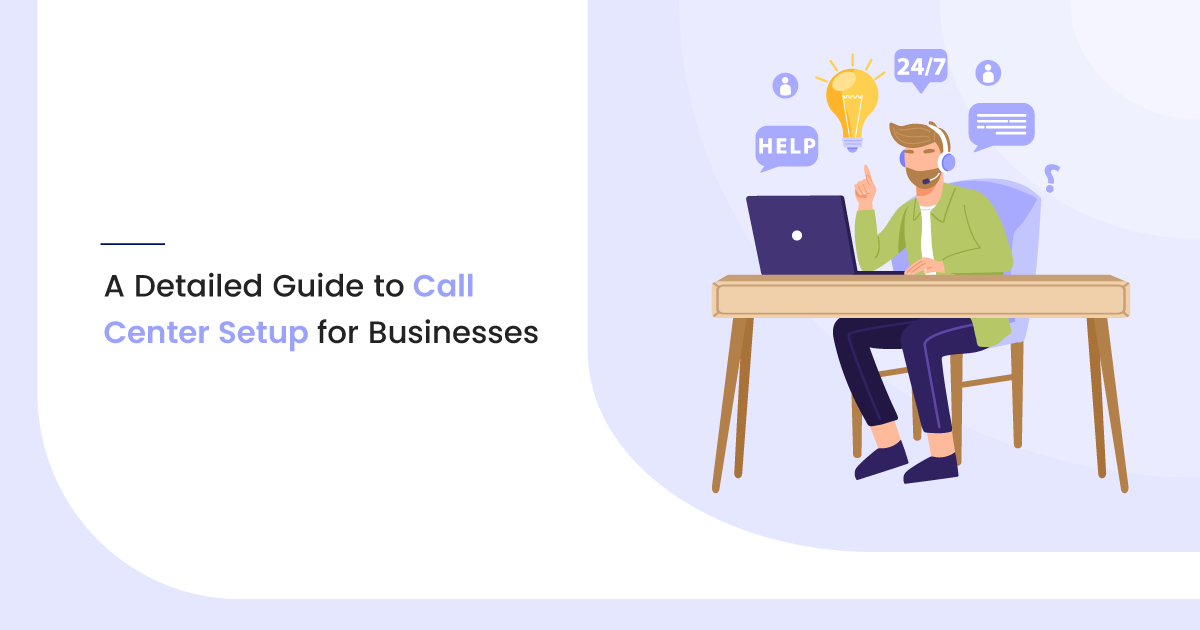The origin of call centers dates back to the 1960s when a UK-based press and mail company installed the world’s first PABX system. But it was not until the 90’s when customer support became streamlined.
However, the new call center setup required a substantial upfront investment, which caused a barrier for most companies.
Now with VOIP technology and cloud-based call center systems, the cost of setting up a call center has significantly curbed. Besides, the rise of IT has enabled any company, regardless of its tech proficiency, to set up and run a call center for its customers.
In this guide, you’ll learn a step-by-step process to set up a call center and the costs associated with it. Let’s get started.
How much does a call center setup cost?
Call centers can be of various types. Vacated call centers are the least expensive options. They require minimum up-front investment and can be set up quickly. However, vacated call centers may be associated with a hidden center setup cost of mechanical and electrical systems.
You can also convert a former retail space into a call center. These facilities already have large floor plates and ample amenities. On the downside, you’ll need a significant amount of capital to revamp these facilities into fully-functional call centers.
Last, you can opt for built-to-suit facilities. The recent surge in demand for call center space has resulted in the availability of ground-up, built-to-suit call centers. These spaces are developed specifically to meet your needs and requirements. However, these facilities require financial agreements with banks. Thus, only well-capitalized companies should go for built-to-suit facilities.
Depending upon what type of call center facility you choose, your costs can oscillate between $2,500 and $10,000. Some key factors that influence call center setup cost are:
- Annual base rental rates ($4-15 per sq. ft.)
- Annual operating expenses ($5-6 per sq. ft.)
- Landlord construction allowance ($0-40 per sq. ft.)
- Tenant construction cost ($0-20 per sq. ft.)
- Furniture ($250-1,000 per workstation)
- Cabling ($250 per workstation)
- IT & Telephony Equipment ($250-750 per workstation)
- Back-Up Generator ($0-$200,000)
6 Steps to call center setup
Step 1: Define the type of call center you need
Determine the focus of your business and the type of services you provide. You can focus on responding to incoming calls, make outbound calls to customers, or have a blend of both.
Let’s discuss each of these types in brief.
Inbound: An inbound call center provides services like taking orders, responding to inquiries, and customer support. Agents in inbound call centers don’t make calls, but they receive calls from the customers.
Outbound: The opposite of inbound, outbound call centers focus on outgoing calls. Outbound call center agents engage in telemarketing, lead generation, cold calling, setting up appointments, etc.
Blended: There’s also a third type of call center, which offers a blend of inbound and outbound calling. Referred to as blended call centers, these facilities are capable of both making outgoing calls and receiving incoming calls.
Step 2: Select the right call center software
You’re not planning to give your agents a bunch of leads written on a paper and expecting them to update it manually. Or are you?
A call center agent could be swamped under a dozen jobs other than calling, such as data entry, updating the CRM system, recording calls, and more. A call center solution automates these recurring tasks, ensuring that your agents focus on their primary job – calling.
There are numerous call center solutions of different types and functionalities. Some common types include:
- Interactive Voice Response (IVR)
- Computer Telephony Integration (CTI)
- Automatic Call Distributor (ACD)
- Predictive Dialer
Modern-day call center solutions offer a mix of the aforementioned types to ensure enhanced functionality.
Selecting the right call center software is an essential part of the call center setup process. So, be mindful of factors like integrations, service, security & compliance, call distribution, and usability.
Step 3: How Callers Can Access Your Agents
The next step towards a successful call center setup is to determine how callers will contact your agents. Do they get directly on call? Or do they go through an Interactive Voice Response (IVR)?
IVR: The IVR approach is more efficient. The intelligent automatic responder collects the basic caller information and displays it on the agent’s screen. This way, the agent can access caller information and prepare for more productive interactions.
Self-service: In the self-service approach, your callers get directly connected with the agents. This approach is beneficial in outbound calling as the customers won’t have to go through a long IVR process.
Step 4: Define Skill Oriented Groups
Depending upon your operations and requirements, you can define skill-oriented groups. Let’s say you provide support for a SaaS website development tool, like Wix or Squarespace. To handle customer queries, you’ll need to have agents that specialize in front-end, back-end, hosting, plugins, and the like.
In the case of an outbound call center, you may need agents that specialize in particular products.
It all depends on the type of call center and its requirements. Just be sure not to go with a one-for-all approach where an agent is taking care of everything.
Step 5: Create Data Format for your Dialers
For the outbound call center setup, you’ll need to define the data format for your dialers. This step is essential to program your dialer about where to find phone numbers to dial and how to find qualified leads. As a result, your dialer can automatically dial numbers when you run an outbound calling campaign.
Step 6: Evaluate
You’re all set to get your call center rolling. The next big step is to evaluate your agent’s performance. Define clear key performance indicators (KPIs) depending on your call center type and objectives to track and measure agent efficiency.
Benefits of setting up a call center
More than half of Americans have canceled a planned transaction or purchase because of bad service. In fact, US companies lose more than $60 billion due to poor service every year. On the positive side, 70% of US consumers say they’ve spent more on a company that offers excellent service.
That said, let’s delve into some tangible benefits of call center setup for your business.
1. Cost Control
Call centers help alleviate operational costs in numerous ways. First, you can save on staffing and call center infrastructure, especially if you opt for a built-to-suit facility.
Second, most of the call center processes nowadays are automated. With benefits like predictive dialing and intelligent call distribution, you can save a substantial amount of time and resources.
Last, good customer service increases customer retention. As discussed, companies lose big money due to poor service. By setting up call centers, you can enhance the quality of your support and increase customer retention rates.
2. Improve customer experience
Customers want their queries to be resolved instantly. When customers make a purchase, they want to make sure they can reach out to the company anytime.
Ask yourself. Would you shop from a company that has no customer service number? Emails and e-tickets could be a start, but in order to improve customer experience, you’ll need a call center setup.
3. Increased scalability
We live in a digital era, where most customers shop online. Yet, 49% of people say they are reluctant to shop online. Especially if you are selling high ticket products, relying on online sales could be a catastrophic mistake.
Call centers increase sales and help you avoid lost opportunities. Abandoned carts are prevalent nowadays because a customer wants to make a purchase, but he’s on the fence, doubtful of whether he’s making the right call.
Having a trained call representative contact these customers and solve their queries can go a long way in increasing your sales and scaling your business.
4. Data Security
Data theft and breaches are some of the worst nightmares for any business. Even a small loophole in security can invite the risk of losing sensitive data, leading to potential damage to your reputation.
A call center setup includes impenetrable security features that keep both customer and company information safe. You can also add multi-factor authentication to restrict access to sensitive data to selected personnel only.
Moreover, by investing in a cloud-based call center system, you can backup your information and revive it in case of data loss or theft.
5. Improve Call Quality
Trained call center agents work on their feet and can respond to a query on short notices. As mentioned, customers want their issues to be resolved promptly. A call center set up with experienced agents can improve call quality and customer experience.
This holds true specifically for outbound calls. Cold calling or telemarketing is a significant driver of business in today’s digital age. A skilled telemarketer can make a huge difference in making fruitful relationships with customers and generating consistent revenue.
Final thought
With the call center market continuously expanding and setup facilities advancing, setting up a call center is easier than ever before. By investing in the right call center technology and talent, you can add a layer of customer satisfaction and scalability to your business.
So, please share with us what call center setup challenges are you facing?
Need Any Technology Assistance? Call Pursho @ 0731-6725516




